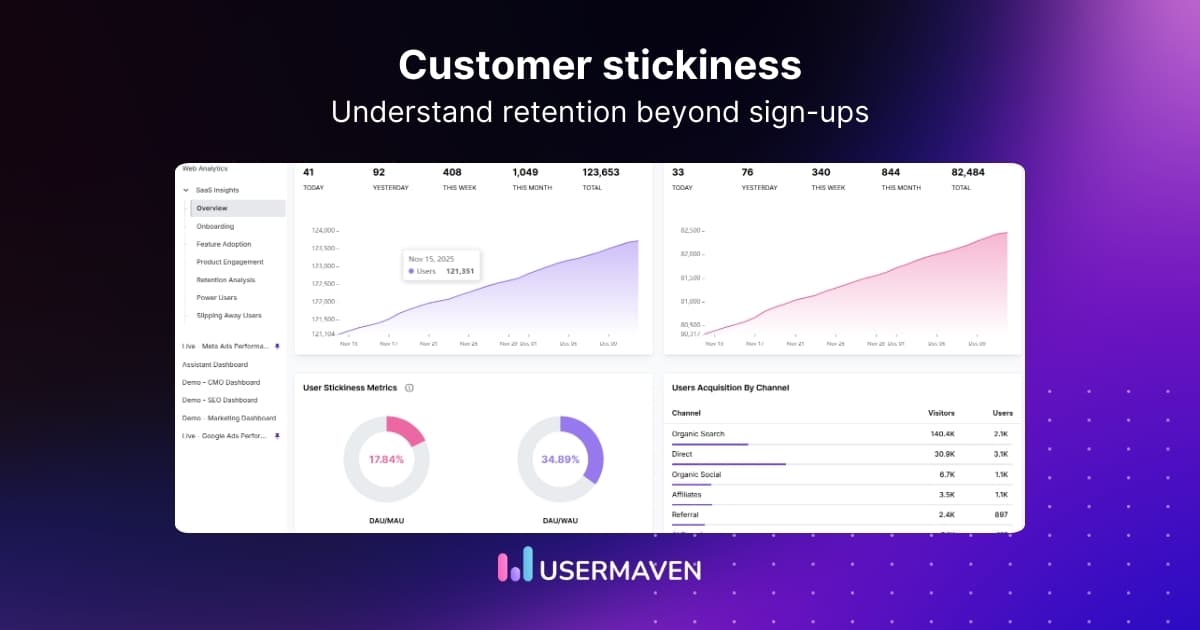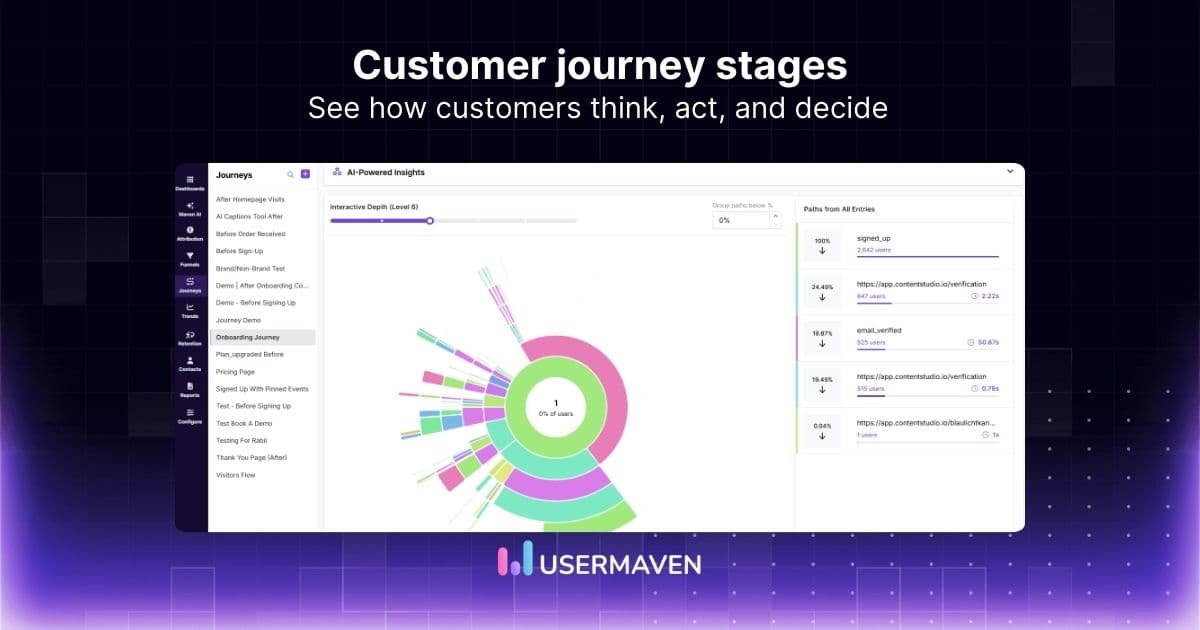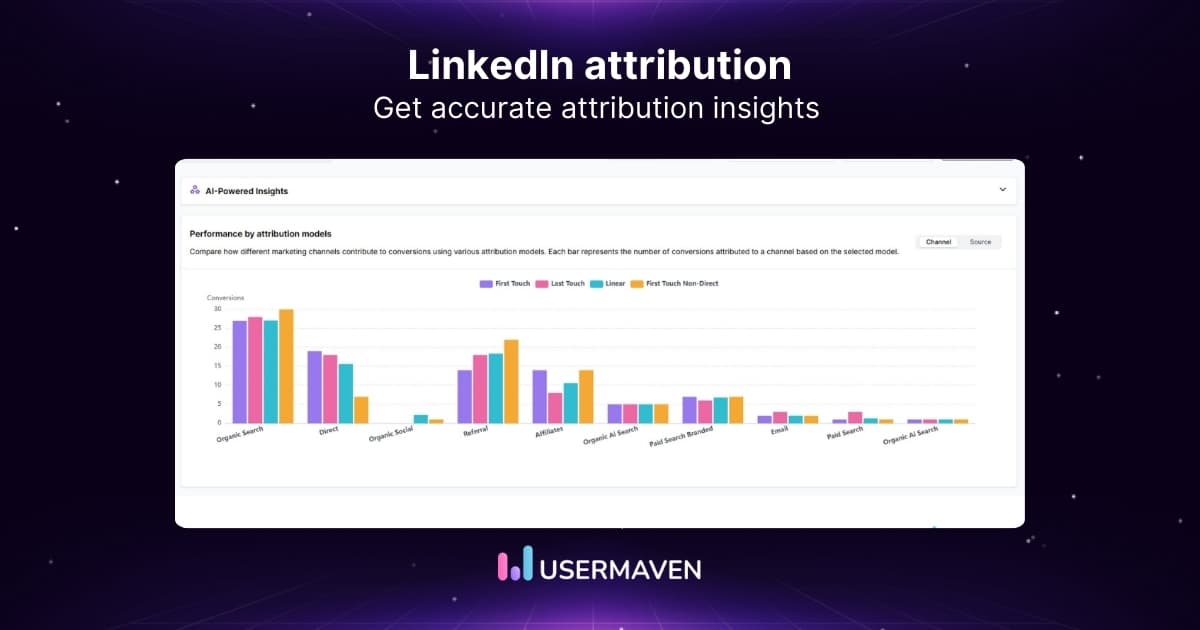How to choose the right customer segmentation KPIs
Oct 7, 2022
4 mins read
Written by Usermaven

In the business world, you know that customer segmentation is key to success. But what are the right customer segmentation KPIs to track for your business?
This blog post will show you how to choose the right KPIs to develop an effective marketing campaign.
Segmenting customers by needs and wants
Are you looking to better understand your customers and establish a more targeted marketing campaign?
If so, then segmentation is a technique you should consider.
Dividing your client base into customer segments based on their shared characteristics is called segmentation. This can be done in a number of ways but is often done by looking at needs and wants.
Needs are the basic requirements a customer has for a product or service. For example, if you sell cars, a customer’s need would be transportation.
Wants are the additional features or benefits a customer desires. For example, a customer may want a car that is stylish or sporty.
Once you have segmented your customers by needs and wants, you can then build targeted marketing campaigns that are more likely to resonate with each group.
To do this effectively, you need to have a good understanding of your customer base and what they are looking for. You also need to have good data to support your segmentation analysis.
If you don’t have this data, don’t worry. There are a number of ways to collect it, including surveys, customer interviews, and focus groups.
Once you have this data, you can start to segment your customers and create more targeted marketing drives. And, if you use the right segmentation KPIs, you can measure the success of your campaigns and make necessary adjustments.
Target the right audience
with Usermaven Segments
*No credit card required
Grouping customers by demographics
One way to segment your customers is by grouping them by demographics. This can be helpful in understanding who your customers are, what they want, and how to best reach them.
There are a number of demographic factors you can use to segment your customers, including:
- Age
- Gender
- Income
- Location
- Education
- Marital status
- Occupation
Once you’ve decided which demographic factors to use, you need to define your segments. For each demographic factor, you’ll want to create a segment that represents a group of customers with similar characteristics.
For example, if you’re using age as a demographic factor, you might form segments for the 18-24 bracket, customers aged 25-34, and so on.
Once you’ve defined your segments, you can start to think about how to focus on each one.
What marketing messages will resonate with each group?
What channels should you use to reach and update them?
Answering these questions can be difficult, but segmentation analysis can help. By understanding your customers better, you can create more targeted and effective marketing efforts that will ultimately lead to more sales.
Dividing customers into market segments
In the business world, it’s important to understand your ideal market and divide them into segments. By doing this, you can more easily build marketing campaigns that are tailored to each group, increasing your chances of conversion.
There are a few different ways to do this. As mentioned above, the most common method is by demographics, such as gender, income, location, etc. Another way to segment it is by behavior, such as what types of products or services they’re interested in, how often they purchase, and how much they’re willing to spend.
Once you determine how you want to segment your entire market, you need to choose the right segmentation KPIs. These are the metrics that you’ll use to measure the success of your marketing strategy.
Some of the most important KPIs for segmentation include conversion rate, customer lifetime value, and customer satisfaction.
When you identify these KPIs, you can see which segments are most responsive to your marketing efforts and make changes accordingly.

(Source)
Creating customer personas
By developing customer personas, you can gain a better understanding of your target audience, which can help you make more informed decisions about your marketing and sales strategies for your company.
When it comes to creating customer personas, one of the most important things to consider is your segmentation KPIs. These key performance indicators can help you track and measure the success of your customer persona strategy.
There are a few different ways to go about defining your KPIs.
One approach is to identify the demographics of your audience. This can include factors such as gender, location, income level, etc.
Another approach is to focus on the needs and wants of your selected audience.
- What are they looking for in a product or service?
- What are their pain points?
Once you have a good understanding of your target audience’s needs and wants, you can begin to develop customer personas that address those needs.
Once you have your KPIs in place, you can begin to curate content that appeals to your audience. This can include blog posts, social media content, e-books, digital art, and even marketing campaigns.
By creating content that resonates with your ideal audience, you can increase the chances of converting them into clients and boosting customer engagement.
If you’re not sure where to start, there are a number of tools available to help you get started with developing customer personas. There are also a number of software programs that can help you automate the process.
When it comes to KPIs, the most important thing to remember is that they should be constantly monitored and reviewed. By doing so, you can ensure that your customer persona strategy is on track and achieving the desired results.
Analyzing customer behavior
Are you looking to improve your segmentation? Then you’ll need to analyze customer behavior!
One of the best practices to do this is by using segmentation KPIs.
What are customer segmentation KPIs?
They are key performance indicators that help you track and analyze customer behavior. By using them, you can better understand your customers and fine-tune your marketing efforts.
There are a few different types of segmentation KPIs, but some of the most important ones include:
- Customer lifetime value
- Customer acquisition costs
- Customer churn rate</l i>
- Customer satisfaction score
Each of these KPIs provides valuable insights into customer behavior, customer loyalty, customer experience, and customer retention. By tracking and analyzing customer engagement, you can make better decisions for your business.
So, if you’re looking to improve your segmentation process, make sure to start with customer segmentation!
Target the right audience
with Usermaven Segments
*No credit card required
Conclusion
Customer segmentation is an important tool to explore for any business owner, and the right KPIs can make all the difference in your success. By understanding your customer base and tracking the right metrics, you can ensure that your company is on track for long-term growth.
Frequently asked questions
What is segmented KPI?
A segmented KPI is a key performance indicator that is specific to a particular customer segment. Segmented KPIs help businesses track and measure the performance of their marketing and sales efforts in relation to specific customer segments.
This information can then be used to make informed decisions about how to allocate tools, resources, and tailor strategies to better meet the needs of each customer segment.
How do you measure customer segmentation?
Some common ways to measure segmentation include looking at customer demographics, behaviors, and/or needs. Additionally, businesses may also use surveys or other forms of feedback in order to gauge customer satisfaction levels and get a better insight into their users.
What are the 4 types of customer segmentation?
There are four types of segmentation:
- Geographic segmentation
- Demographic segmentation
- Psychographic segmentation
- Behavioral segmentation
Try for free
Grow your business faster with:
- AI-powered analytics & attribution
- No-code event tracking
- Privacy-friendly setup


